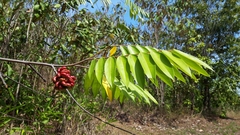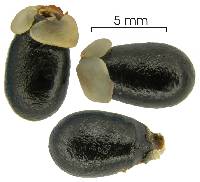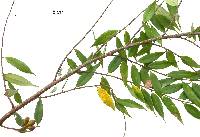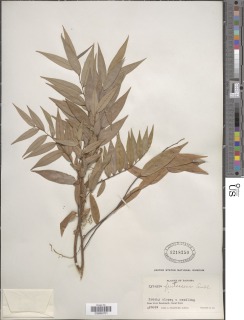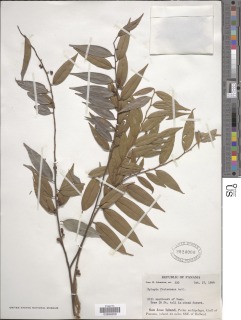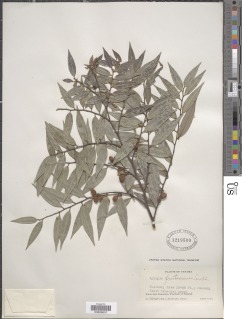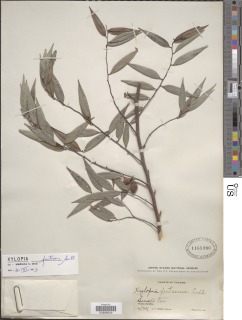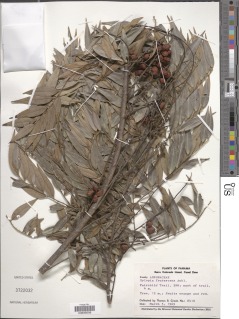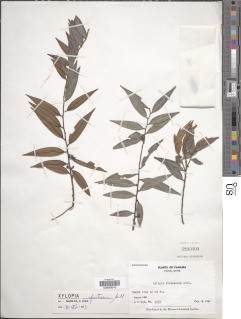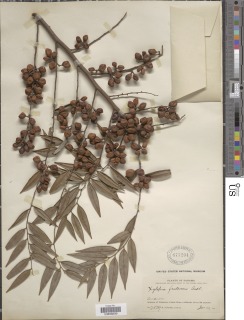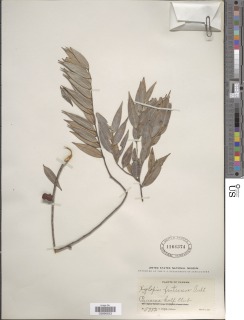

|
|
|
|
Family: Annonaceae
Malagueto, more...malagueto macho
[Xylopia setosa Poir.] |
Description: A medium-sized tree with very small leaves and a distinctive crown. The branches are long and can have many leaves; the leaves are pointed, arranged in a flat plane, regularly-spaced, alternate. The leaf underside has a soft, bluish color, and the secondary veins appear to be absent (they are there, though, and visible under close examination). On larger trees, the long branches droop is such a way that from a distance, the entire crown appears pointed at the top, in the shape of a Christmas tree. Reproduction: Produces small white flowers on the branches, from May to August. Fruits mature from October through March, and many small birds collect in Xylopia for the small berries (this is a good species for collecting birds along Pipeline Road). Distribution: A common roadside and farmland species throughout the Canal area, rare or absent within forest, found on the dry Pacific slope to the wet Santa Rita ridge. Common along Pipeline Rd. Similar Species: Since there are no conifers (needle-leaved trees) in the Panama lowlands, any Christmas-tree-like form must be a Xylopia. This and LK xyl1ar X. aromatica LK2 both occur in the same roadside habitat, and both have the strange, pointed crowns, but they are easy to separate by leaf size. Both are readily identified as saplings by the bluish leaf undersides, lack of secondary veins visible on the leaf underside, and the long branches with regularly-spaced leaves. Uses: The wood is hard and much-used by local farmers for construction and tools. Descripción: Árbol de 5 a 10 m de alto. Copa pequeña y en forma de árbol de navidad. Tronco delgado y cilíndrico. Ramas largas y arqueadas hacia arriba. Ramitas terminales cilíndricas y con lenticelas blancas. Hojas simples y alternas, de 3-7 x 1-2 cm, lanceoladas, con ápice agudo, bordes enteros, a veces revolutos por el envés y base redondeada. Las hojas son dísticas a lo largo de las ramas y tienen el envés blanco o gris. Pecíolo de 0.3-0.5 cm de largo. Flores blancas o cremas, ubicadas en pequeñas agrupaciones a lo largo de las ramitas. Frutos en monocarpos cilíndricos, de 1-1.5 cm de largo, verdes, tornándose amarillos o rojos y dehiscentes al madurar. Datos Ecológicos: La especie crece a bajas elevaciones en bosques secos o húmedos. En Panamá se encuentra en las provincias de Chiriquí, Coclé, Colón, Darién, Los Santos, Panamá, Veraguas y la comarca de Guna Yala. Común y fácil de observar a orillas de carreteras, caminos y bosques secundarios. A veces ocurre en el interior del bosque. Florece y fructifica durante todo el año, principalmente de abril a junio. Especies Parecidas: A menudo se confunde con LK xyl1ar Xylopia aromatica LK2 , pero en X. aromatica las hojas son de mayor tamaño y las ramas son largas y colgantes. LK xyl1se Xylopia sericea LK2 es un árbol muy parecido, pero en Xylopia sericea las hojas tienen pelos seríceos y plateados por el envés, lo cual no ocurre en X. frutescens. Usos: La madera es empleada para postes de cercas y leña. De la corteza se extraen fibras utilizadas como cuerdas para amarrar. Las semillas son venenosas, se mezclan trituradas con maíz para matar ratones. En las regiones de la campiña interiorana los frutos se cocinan con la chicha de maíz, para darle un sabor picante. Los frutos se utilizan para curar el dolor de estómago y los parásitos intestinales. Malagueto hembra Slender tree, to 19 (25) m tall; branches clustered toward apex of tree, arcuate, ascending; stems when young pilose, in age dark, glabrate, and lenticellate. Petioles pilose, 3-5 mm long; blades lanceolate, acuminate, acute to obtuse at base, 3-6 cm long, 8-10 (15) mm wide, stiff, glabrous above, sericeous below. Flowers ca 1 cm long, in short axillary clusters of 1-5 each, sweetly aromatic; pedicels very short, bracteate; sepals 3, ovate, to 2.3 mm long, connate at base, sericeous outside, glabrous inside; petals 6, valvate, greenish-white and +/- erect at anthesis, oblong, blunt at apex, the outer 3 to 11 mm long and 2.5 mm wide, sericeous outside, the inner 3 slightly shorter and much narrower; stamens greenish, ca 1.3 mm long; style triangular-conic, to 5.3 mm long, white, fleshy, soon deciduous; stigma simple. Monocarps irregular, ca 1.5 times longer than wide, to 1.2 cm long and 7 mm wide, rounded at both ends, orange to red, (1) 2 (3)-seeded, the short stipe off-center; seeds ovoid, black, ca 6 mm long. Croat 4868, 8418. Guatemala to southern Brazil. In Panama, ecologically variable; a typical component of tropical dry forest (Holdridge & Budowski, 1956) and tropical moist forest (Tosi, 1971), but known also from premontane dry forest in Coclé from premontane moist forest in Panama, from premontane wet forest in the Canal Zone and Panama, and from tropical wet forest in Coclé See Figs. 240 and 241. |
|
|
|


